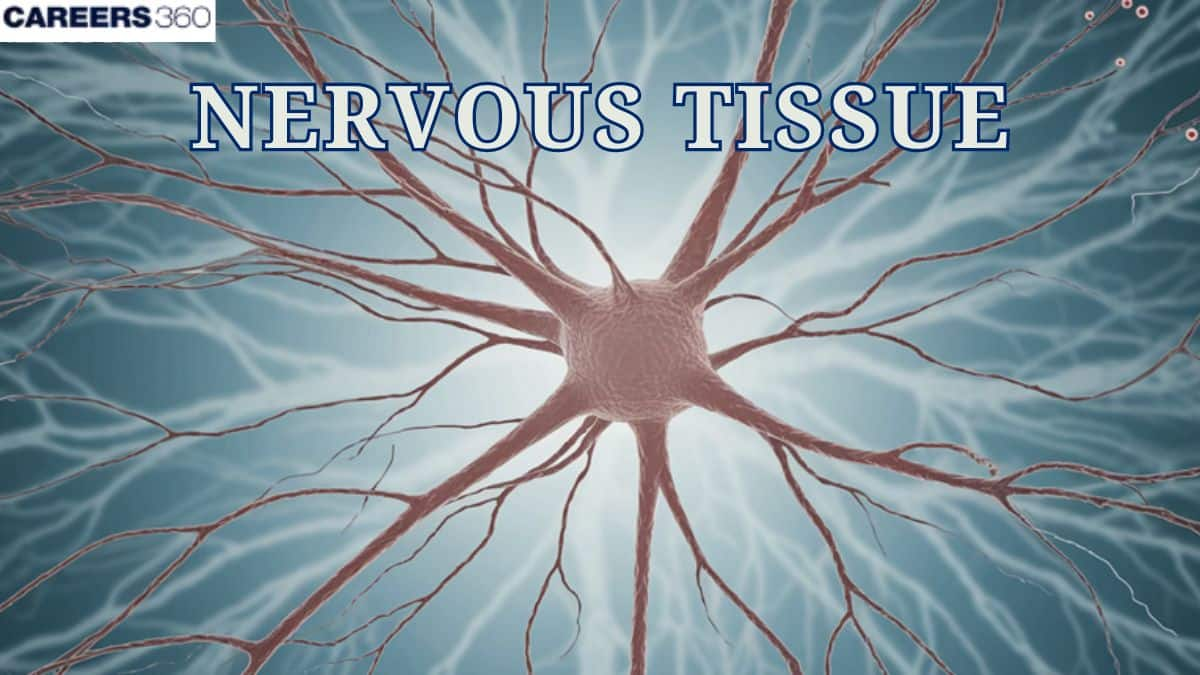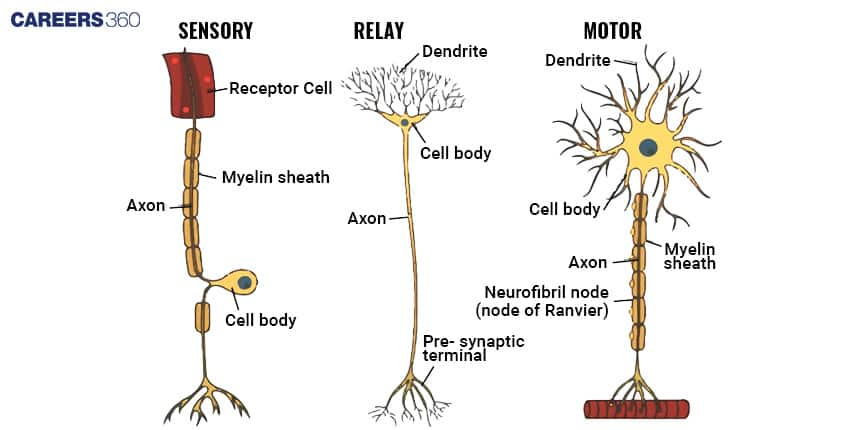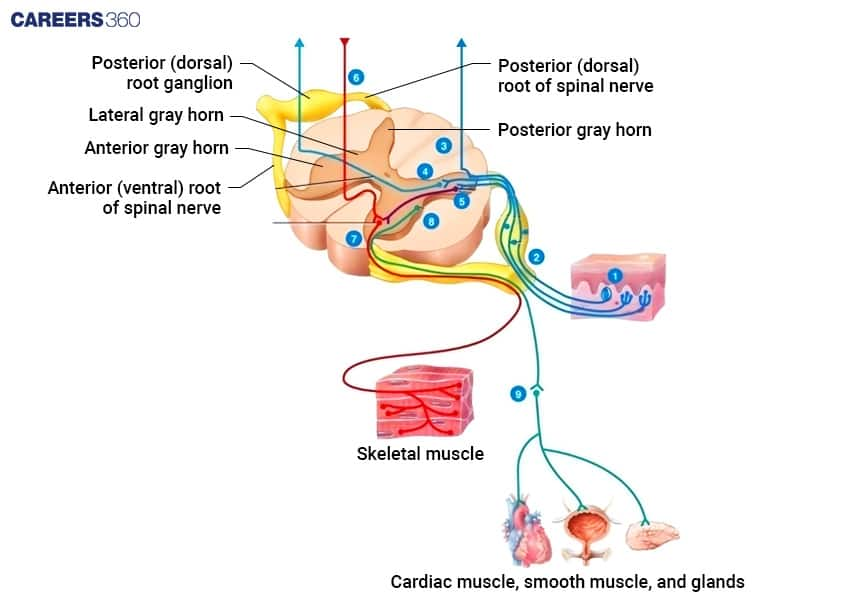Nervous Tissue
Nervous tissue forms the brain, spinal cord, and peripheral nerves, enabling communication, reflexes, and higher functions like memory and thinking. It consists of neurons for impulse transmission and neuroglia for support. A fundamental Class 11 Biology and NEET topic in tissues and physiology.
This Story also Contains
- What is Nervous Tissue?
- Structure of Nervous Tissue
- Types of Neurons
- Nervous Tissue in Central Nervous System (CNS)
- Nervous Tissue in Peripheral Nervous System (PNS)
- Functions of Nervous Tissue
- Properties of Nervous Tissue
- Nervous Tissue NEET MCQs (With Answers & Explanations)
- Recommended video on "Nervous Tissue"

What is Nervous Tissue?
Nervous tissue is the specialised tissue of the body. The major tissue component of the two parts of the nervous system—the brain and spinal cord of the central nervous system. The function of nervous tissue is to transmit and receive external and internal stimuli. Two major types of cells are found in nervous tissue: neurons and glial cells. This tissue permits the body to react to stimuli, keeping the organism alive by providing ways for the different body parts to communicate with each other speedily.
Structure of Nervous Tissue
The structure of the nervous system is explained below-
Neurons (Dendrites, Soma, Axon)
Neurons are a unique kind of cell that carries nerve impulses and forms the essential functions of the nervous system. They mainly work with receiving sensory input, processing information, and responding by conveying the required message to the muscles and glands.
The three main parts of a neuron include dendrites, which obtain signals from other neurons, the cell body (or soma) containing the nucleus in which the information is processed, and the axon, which conducts the impulse generated by the cell body away to other neurons or an effector cell.
Neuroglia (Astrocytes, Microglia, Oligodendrocytes, Schwann Cells)
Neuroglia of the CNS can be classified on the basis of size, cytoplasmic processes, and intracellular organization into four types: astrocytes, oligodendrocytes, microglial cells, and ependymal cells.
Astrocytes are the star-shaped cells have many processes and are the largest and most numerous of the neuroglia. These cells provide a scaffolding on which the framework of the brain is built and help regulate the level of dissolved ions within the tissue.
Microglia are small cells with slender processes that give off numerous spinelike projections. Microglial cells or microglia function as phagocytes within the central nervous system.
Oligodendrocytes resemble astrocytes but are smaller and contain fewer processes. They are responsible for forming and maintaining the myelin sheath around CNS axons.
Schwann cells form the myelin sheath in the peripheral nervous system.
Types of Neurons
Functionally, neurons are classified according to the direction in which the action potential is conveyed with respect to the CNS. The types of neurons are explained below:
Sensory Neurons
Sensory neurons conduct signals from sensory receptors to the CNS for the body to perceive stimuli like light, sound, or touch.
Motor Neurons
Motor neurons transmit a signal from the CNS to muscles or glands, which finally produces an action such as muscle action or secretion of the glands.
Interneurons
Interneurons transmit messages as they connect one neuron to another in the CNS. They are responsible for processing information received from the sensory neurons and transmitting the information to the motor neurons so that the body can react.

Nervous Tissue in Central Nervous System (CNS)
The type of the nervous tissue in CNS is explained below-
Role in Brain (Grey & White Matter)
Nervous tissue in the brain participates in higher activities, including thinking, memory, emotion, and sensory perception. It contains within its structure grey matter, or the cell bodies of neurons – and white matter, first and foremost the axons, which are made up of fibre tracts of neuronal processes.
Role in Spinal Cord (Integration & Conduction)
The spinal cord communicates to and from the brain and integrates, but does not generate, much of the information to and from the brain. Accordingly, the spinal cord provides a means for the flow of information between the brain and the rest of the body. Grey and white matter exist within nervous tissue.

Nervous Tissue in Peripheral Nervous System (PNS)
The type of the nervous tissue in PNS is explained below-
Role in Peripheral Nerves
The peripheral nerves are the bundles of the axons that carry the sensory and motor information from the CNS to the body, in return. PNS. Hence, these radiate voluntary, and involuntary actions.
Connection Between CNS and PNS
The peripheral nerves connect the central nervous system to the limbs and organs, so stimulus perception can reach the CNS and motor response can reach effectors — all of which will further enable it to cope with the surrounding interaction.
Functions of Nervous Tissue
The functions of the nervous tissue are explained below:
Transmission of Nerve Impulses
Nervous tissue can conduct electrical signals through neurons in the type of action potentials extremely fast, resulting in fast responses to various stimuli.
Coordination And Integration
Nervous tissue integrates all the sensory information and associates body functions so that homeostasis can be maintained and the body may interact effectively with the environment.
Reflex Actions
Nervous tissue initiates rapid and involuntary responses to any stimuli and, therefore, allows prompt precise protective actions and corrections.
Properties of Nervous Tissue
The properties of the nervous tissue are explained below:
Excitability
Nervous tissue can respond to stimuli and communicate the response using electrical impulses, which are fundamental to the functions of sensing and responding to changes in the environment.
Conductivity
Nervous tissue conducts electrical impulses over long distances to ensure effective communication between various body parts.
Secretion
Neurons secrete neurotransmitters at synapses by which communication between neurons and other cells is mediated, which is of significant importance in the process of signal transmission.
Nervous Tissue NEET MCQs (With Answers & Explanations)
Important topics that are frequently asked in the NEET exam are:
Structure of Neuron
Types of Neurons (Sensory, Motor, Interneurons)
Neuroglia (Supporting Cells)
Difference between grey and white matter.
Reflex arc
Practice Questions for NEET
Q1. The neural tissue originates from
Endoderm
Ectoderm
Mesoderm
All of these
Correct answer: 2) Ectoderm
Explanation:
Nervous tissue originates from the ectoderm. The ectoderm gives rise to the neural tube, which later develops into the brain and spinal cord. The ectoderm is the outermost germ layer in the early embryonic development of animals.
Hence, the correct answer is option 2) Ectoderm
Q2. Which of the following are the features of neural tissues?
Irritability
Conductivity
Response
All of these
Correct answer: 4) All of these
Explanation:
Neural tissue, or nervous tissue, is crucial in animal bodies for its ability to facilitate communication via electrical signals. This tissue is composed primarily of neurons and glial cells.
Neurons are the core functional units, with three distinct segments: the cell body (soma), dendrites, and axon. The soma houses the nucleus and organelles, while the dendrites receive signals from neighboring neurons. The axon, on the other hand, transmits electrical impulses from the soma to distant regions.
Glial cells, or neuroglia, are essential for supporting and safeguarding neurons. They also contribute to the transmission process. Notable glial cells include astrocytes, oligodendrocytes, and Schwann cells, each playing a specific role in maintaining the neural environment and signal propagation.
Hence, the correct answer is option 4) All of these.
Q3. What is the role of the nodes of Ranvier in saltatory conduction?
To slow down the conduction of the action potential
To allow the action potential to propagate continuously down the axon
To speed up the conduction of the action potential by providing a site for ion channels
To prevent the action potential from reaching the axon terminal
Correct answer: 3) To speed up the conduction of the action potential by providing a site for ion channels
Explanation:
In myelinated axons, the nodes of Ranvier are the spaces between adjacent myelin sheaths. Ion channels, especially voltage-gated sodium and potassium channels, are abundant in these nodes. When an action potential reaches a node of Ranvier, the membrane depolarizes, allowing sodium ions to enter the axon and depolarize the membrane, which causes the generation of a new action potential. This process also causes voltage-gated ion channels to open. As a result of the rapid depolarization and repolarization that takes place at the nodes of Ranvier, the action potential can "jump" from node to node and spread along the axon with great speed.
Therefore, the nodes of Ranvier play a crucial role in saltatory conduction, as they enable the action potential to propagate more quickly along myelinated axons than it would in unmyelinated axons.
Hence the correct answer is option 3) To speed up the conduction of the action potential by providing a site for ion channels.
Also Read:
Recommended video on "Nervous Tissue"
Frequently Asked Questions (FAQs)
The nervous tissue is a specialised tissue constituting the entire nervous system and is responsible for conducting electrical impulses throughout the body. The primary function of the nervous tissue is to coordinate and control body activities by receiving, processing, and responding to sensory information.
There are three categories of neurons: sensory neurons, motor neurons, and interneurons. Sensory neurons convey information from the receptors into the CNS, motor neurons convey information from the CNS out to the muscles or glands, and interneurons connect neurons in the CNS with other neurons.
The neuroglia or glial cells are known as supporting cells in the nervous tissue. They are composed of astrocytes, microglia, oligodendrocytes, and Schwann cells, all performing different supporting, protecting, and nourishing functions about the neurons.
The nervous tissue transmits the signal to the effector cell using action potentials that occur in neurons. These are electric impulses sent along a neuron's axon, which are transmitted to other concerned neurons or effector cells across synapses.
The most common disorders that are associated with nervous tissue include Alzheimer's disease, Parkinson's disease, multiple sclerosis, epilepsy, and neuropathy. These represent a diversity of conditions that affect the functioning as well as the structure of one's nervous system, with concomitant neurological symptomatology.